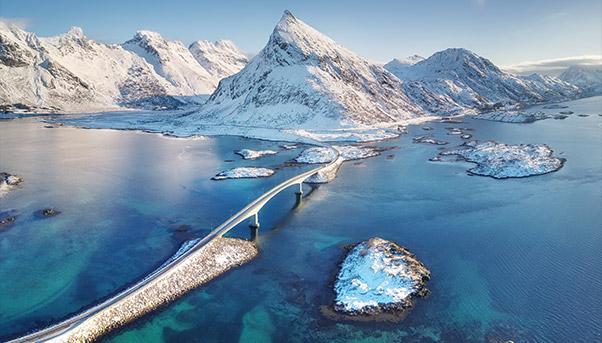
The Norwegian Public Roads Administration (NPRA), the government agency that oversees the country’s road network, has approved a design for the world’s longest floating bridge — part of a record-setting transport infrastructure project to upgrade its E39 coastal highway.
The floating Bjørnafjord Bridge will be built over a distance of roughly five kilometres (3.1 miles) and suspended over a fjord that is 550 metres (1,804 feet) deep, at a cost of at least $1.3 billion.
In recent weeks, the NPRA has picked a design solution prepared by two separate teams. The construction contract is expected to be open for bidding in 2022.
The record-setting bridge across the fjord
This bridge is ambitious not only because it covers a distance of five kilometers. It has a single suspended span of 300 meters (984 feet) that permits large ships to cross the fjord. Even the shape of the bridge will be unique. Its curved design follows the needs of the route, but also protects the vehicles from powerful crosswinds that blow across the fjord. “Wind is actually as much a dominant feature as waves of the sea and the currents,” Mathias Egeland, member of the NPRA and project manager of the bridge, told ENR magazine.
To make sure the bridge will hold up – since it is impossible to sink piers to bottom of the fjord — it will be anchored by a complex system of moorings. The system will be replicated on the other large bridges that are part of Norway’s multi-billion-dollar investment to modernise the E39.

The bridge over the Sognefiord
The Bjørnafjord Bridge, located south of Bergen, takes its cue from the bridge over the Sognefjord, Norway’s largest fjord. For the crossing of the great fjord — 3.7 kilometres (2.2 miles) wide and 1,300 metres (4,265 feet) deep — a complex system is planned that combines bridges and tunnels.
Another record is in the making with the Rogfast tunnel, the world’s longest underwater tunnel (26.7 kilometres, or 16.5 miles) connecting the cities of Bergen and Stavanger. Norwegian parliament approved the Rogfast works on May 23, 2017 and construction started at the end of that year. The tunnel will reach a maximum depth of 392 metres (1,286 feet) below sea level and has a price tag of $1.9 billion. It is scheduled to be completed between 2025 and 2026.
Both projects, as well as that of the Bjørnafjord bridge, are part of the long-term plan for E39 motorway, which runs for 1,100 kilometres (683 miles) and is interrupted by seven ferry crossings over the fjords.
The new motorway under construction will replace the old one with a series of bridges and tunnels that will significantly reduce journey times from the current 21 hours to 11 hours. It will also cut freight costs by 50%. It will also cut freight costs by 50%.
Motorways and more
Norway’s National Transport Plan was approved in 2018, and several of its projects are already under way, like the flagship $40 billion renewal of the E39. But the highway renewal plan is just a part of an overall effort to promote sustainable, efficient and faster transport by also investing in the country’s railway network. Salini Impregilo is leading a consortium that has won a contract worth €388 million euros for a 13.6 km-long (8.4 mile) railway stretch between the cities of Nykirke and Barkaker, south of the Norway’s capital Oslo. The contract calls for the construction of a double-track line, including two bridges, three tunnels and a station near the town of Skoppum. Overall, it is part of a plan for a new railway line between Oslo and Tønsberg to be completed by 2024, with a maximum frequency of four trains an hour in both directions.

